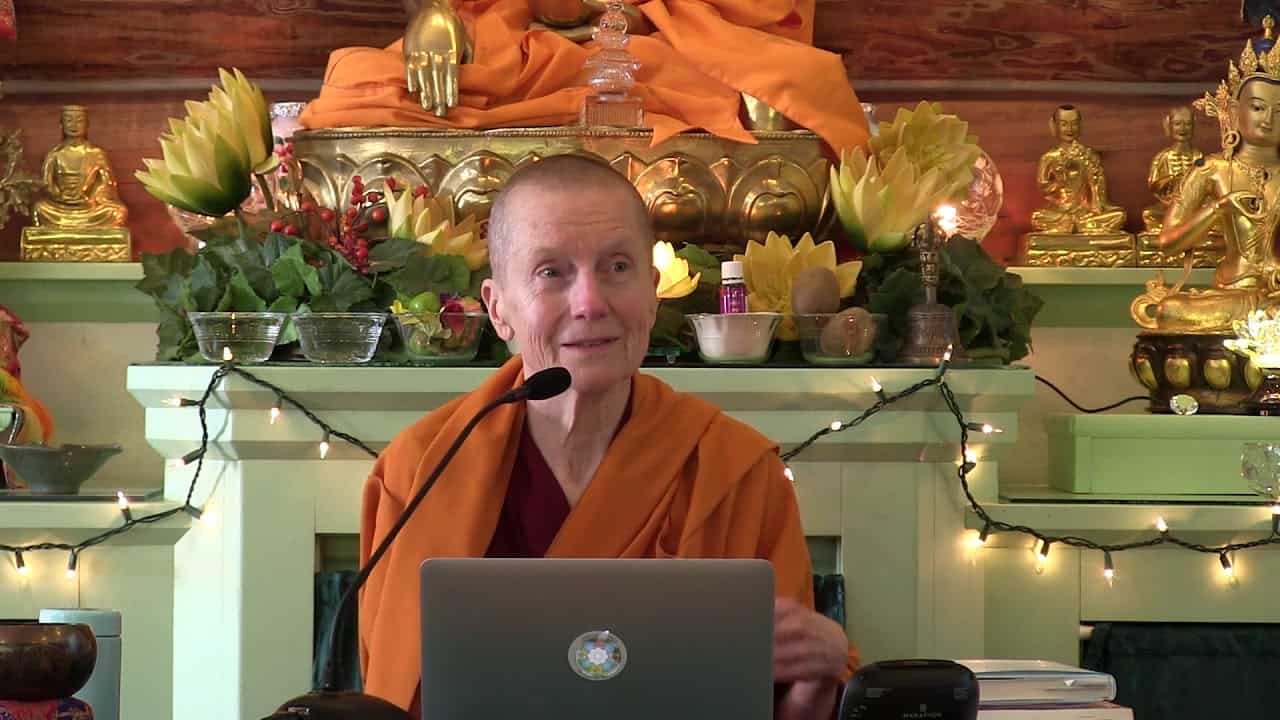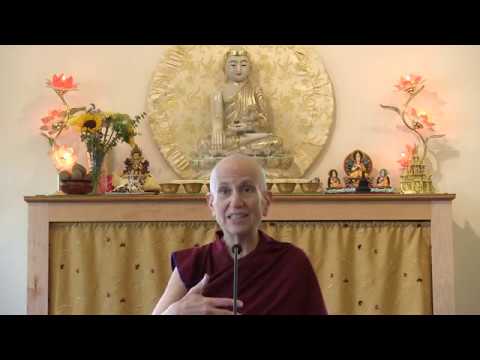Tonglen: Taking and giving
Part of a series of short Bodhisattva's Breakfast Corner talks on Langri Tangpa's Eight Verses of Thought Transformation.
- A basic overview of the taking-and-giving meditation
- What “dukkha” means
- Working with the mind that trembles at doing this meditation
This verse talks about the taking and giving meditation. Tonglen, in Tibetan. This is very powerful. Its roots lie in Nagarjuna, in a verse in Precious Garland. And then, of course, Shantideva talked more about it. It’s in the lineage of equalizing and exchanging self with others.
The most extensive explanation I’ve seen of it was given by Khensur Jampa Tegchok in Chapter 11 of Transforming Adversity into Joy and Courage. I highly recommend that. I can’t give a detailed version of that now. That book is really quite incredible, the amount of detail he went into.
Basically, what’s happening in the taking and giving meditation is it’s designed to help us generate love and compassion, and increase the strength of our love and compassion. Love being the wish for other beings to have happiness and its causes. Compassion being the wish for them to be free of suffering and its causes. The way that it’s done is you imagine either an individual or a group of people and think of the kind of dukkha they have.
Remember, dukkha doesn’t just mean “ouch” suffering. It doesn’t mean that they’re sick or depressed. It could mean that. But it could also mean the dukkha of change, that whatever happiness they have fades and can easily turn into actual pain. And then the third kind of dukkha, that just having a body and mind, the five aggregates, under the power of afflictions and karma is unsatisfactory. We want to make sure when we do this, that we include all three. That we’re not just focused on the pain that everybody can recognize.
To generate compassion for beings undergoing whatever form of dukkha we’re thinking of at that moment and imagine it leaving them in the form of pollution, and then we inhale that pollution. The pollution doesn’t just come inside us and hang around and make us depressed and sick. Rather, as we’re inhaling it, it transforms into a lighting bolt, and we imagine our own self-centeredness as a lump at our heart, and as we inhale others’ suffering, it transforms into that lightning bolt, hits the lump of self-centeredness and self-grasping ignorance at our own heart, and completely blows it up.
Some people don’t like that image of something hitting it and then demolishing it. They prefer an image of some kind of organic soap that when you inhale the pollution it changes into that, and then dissolves the lump, kind of like a healthy kind of Ajax. Depends on what kind of image speaks to you. People have different feelings about this.
What we’re basically doing is we’re taking what others don’t want—which is their suffering, their dukkha—and using it to destroy what we don’t want, which is our own self-centeredness and our own self-grasping ignorance. That’s the taking part, we’re taking on others’ misery, others’ dukkha.
After the lump at our heart is totally dissolved, banished, exploded (whatever image you want to use), then you just rest with this open feeling in your own heart, without any self-grasping, without any self-centeredness. Within that open space in your heart, you generate love—the wish for sentient beings to have happiness and its causes—and you radiate that love out to them.
Using what they don’t want to destroy what we don’t want in the taking part. Then in the giving part we’re using the things that we normally are attached to, the things that our self-grasping and self-centeredness cling to, and we’re imagining those things being transformed and enlarged, and given to all the sentient beings in the form of whatever sentient beings need.
We give our body, our possessions, and our merit, our virtue.
In giving our body, we imagine this body transforming into a multitude of different bodies. Or into whatever sentient beings need. I find it helpful to think of the body becoming many other bodies, many other people, so that you can give sentient beings the relationships they need. If they need a doctor, we become a doctor. If they need a friend, we radiate out as a friend. If they need a pet, we radiate out as that. Some kind of living being. Giving our body. This is very effective for reducing attachment to our body, which we have a lot of.
Then we give our possessions. All of our possessions, all of our wealth. Not keeping a little bit under the rug for ourselves for a rainy day. Imagine giving all of it. And again, it transforms into what other sentient beings need. If someone needs a vacuum cleaner, your possessions, you give them a vacuum cleaner. You transform your possessions into whatever others need that is not going to help them create negative karma. You’re giving wisely. It’s not just somebody wants a fishing line and some bait. You’re not going to give that. Or somebody wants some intoxicants. No, we’re not giving that. But whatever we can give, that they need, that will ease their suffering. That’s mostly temporal suffering.
We also give our merit. All the virtue that we’ve created through our practice. And as we know, we work hard to create merit. And to give this, thinking that it manifests in the form of everything sentient beings need, but especially whatever they need in order to practice the Dharma. Our merit can manifest as teachers for them, as books, as conducive circumstances. Even you think you can give them a mind that is open to hearing the Buddha’s teaching, a mind that has faith, a mind that is intelligent and can examine the teachings. It really makes us think about what is it that sentient beings need in order to practice the Dharma.
By giving our merit, and it transforming into what sentient beings need in this way, then we imagine that they become fully awakened buddhas. And then we rejoice. And when we’ve given them our body and possessions, we imagine that their worldly needs are satisfied, and again we rejoice. That’s the giving part of the meditation.
I described it in brief. There’s a lot more to it. Because we can give to the persons. We give to the environment. We give not only to ordinary sentient beings, but we give to aryas, we give to all different sorts of sentient beings.
Sometimes people say they get afraid with the idea of giving, or the idea of taking: “If I take on somebody’s suffering, then I’m going to get their cancer, or I’m going to get their kidney disease.” It’s often said to them, “Don’t worry, because we can’t actually take on somebody else’s karma and experience it ourselves.” Each being experiences the results of their own actions.
But when that nervousness comes up, like, “Oh no, I don’t really want to take it, because then I’m going to get sick,” then that’s pointing out our self-centeredness and our self-grasping, and that’s exactly what the meditation is designed to overcome. So if you have that fear coming up, that’s the point where we really need to stop and go through all the meditations on bodhicitta to really develop our love and compassion so that we are willing to exchange self and others. If helping them entails taking on their sickness, we’re happy to do that. Same thing with the giving part. If benefiting sentient beings entails giving our life, our possessions, our body, our merit, then we’re happy doing that.
Many people like this meditation because it makes you feel good. You’re taking their suffering, giving them their happiness, and that’s nice. But I have a sneaking suspicion that the meditation is actually supposed to invoke all those places where we’re very stuck, where we don’t want to give, and we don’t want to take, because it points that out to us. “If it’s so easy to imagine, I give my body, possessions, and merit to all these sentient beings, and they all become buddhas, and they live happily every after…. But don’t ask me for one of my plastic paper clips. I’ll give you a metal paper clip, but I’m attached to my plastic ones. Don’t ask me for that. But I’ll give you all these other things, my heart is wide open, no self-centeredness….” I wonder, if we feel so blissful doing this meditation, how effective is it if afterwards we can’t even give our plastic paper clips?
Now people think, “Oh what a ridiculous example.” Check up. Check up what you’re unwilling to give, and how easy it is…. Your friend needs to borrow a pair of socks. Do you give them the good pair of socks? Or do you give them a holey pair of socks? Even though they’re only borrowing them. Just in case they don’t return them. Which socks are you giving them? When we give an offering to the Buddha, do we give the nice fruit, or do we give the fruit that’s a little bumped around?
I think the purpose of this meditation is to make us think a little bit deeper, not just space out in Peter Pan bliss, but to really look. “How do I feel? I’m imagining giving my possessions.” Even that whatever it is that we’re very attached to, that you probably haven’t used in five years, but you can’t give away. And the things that we used yesterday, that we’re unwilling to give away.
And then our body. Give away my body? How hard is it, when you’ve taken years to grow your hair out, to cut your hair? And even give away your hair. Which actually isn’t even part of your body. It’s just dead, organic stuff. Okay, maybe I’ll give you my fingernails. But I don’t want to go to the blood bank. And I don’t really want you to take one of my kidneys. Are we willing?
Before I ordained, I had very long hair. It took me years to grow it. My thought of cutting it, it was impossible. I can’t cut my hair. I had to really work at it in my meditations to do that.
We can get attached to anything. We think, “Oh, I’m so generous, you need toilet paper, here’s lots of toilet paper.” Except when you’re on the pot and it’s the last little bit on the roll, and there isn’t anymore in the bathroom. Then our attachment for a few squares of toilet paper becomes very strong. Doesn’t it?
It’s very interesting to really do this meditation and try and overcome those areas where our self-centeredness is really holding on.
If we’re holding onto ideas. You’re a person who likes the cups upside down in the kitchen. Give away a kitchen with the cups right side up. Can you do that? Well yes, I’m giving it to them so they’ll suffer the dirt. [laughter]
It’s very interesting to watch.
Venerable Thubten Chodron
Venerable Chodron emphasizes the practical application of Buddha’s teachings in our daily lives and is especially skilled at explaining them in ways easily understood and practiced by Westerners. She is well known for her warm, humorous, and lucid teachings. She was ordained as a Buddhist nun in 1977 by Kyabje Ling Rinpoche in Dharamsala, India, and in 1986 she received bhikshuni (full) ordination in Taiwan. Read her full bio.


